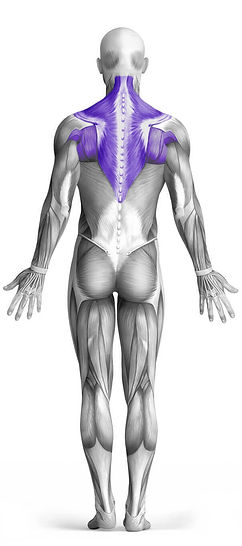Cambered Bar Lying Row 101 Video Tutorial
0

Exercise Synopsis
Target Muscle Group
Upper Back
Execution
Compound
Force Type
Pull
Required Equipment
Barbell
Fitness Level
Advanced
Variations
Alternatives
None
Timer
Hour
Minute
Second
Stopwatch
00:00:00:00
Overview
The Cambered Bar Lying Row is an effective exercise targeting the upper back, with secondary emphasis on the traps, lats, and forearms. Performed by lying on a bench or platform and pulling a cambered barbell towards the torso, this movement engages the muscles of the upper back in a horizontal row pattern. It is a compound exercise that recruits multiple muscle groups, improving both strength and muscle development. The use of a cambered bar allows for a more natural wrist position, reducing strain and enabling better activation of the target muscles. This exercise requires a barbell, making it an accessible and versatile option for those looking to enhance upper back strength and muscle definition.
How to Perform
Start by positioning yourself on an incline bench, ensuring your chest is facing down and your feet are securely placed on the floor for stability.
Grasp the cambered bar with a pronated grip (palms facing downward), keeping your arms extended and allowing the bar to hang directly in front of you.
Maintain a straight back and engage your core muscles to provide support during the exercise.
Begin the movement by pulling the bar towards your lower chest, actively retracting your shoulder blades as you draw the bar in.
Keep your elbows close to your body throughout the entire motion, and at the peak of the pull, squeeze your upper back muscles for maximum contraction.
Gradually return the bar to its starting position, ensuring your arms are fully extended to feel a full stretch.
Perform the exercise for the recommended number of repetitions, maintaining control of the movement at all times.
★ Bonus: For exercises that involve external weights (such as dumbbells, barbells, or machines), the One Rep Max (1RM) calculator can help you estimate your maximum lifting capacity. Use it to track your strength progress and adjust your training for optimal results.
Tips
Focus on maintaining proper form throughout the entire exercise to effectively target and engage the muscles of your upper back.
Gradually increase the challenge by adding more weight or using resistance bands as your strength improves.
Perform each repetition with controlled movements to avoid using momentum, which can reduce the effectiveness of the exercise.
Keep your core muscles engaged throughout the exercise to enhance stability and support your lower back.
Move slowly and deliberately to maximize the activation of your back muscles and maintain full control during the movement.
Keep your shoulders relaxed and down, away from your ears, to prevent unnecessary tension in the neck area.
Focus on your breathing: inhale as you lower the bar and exhale as you pull it up, allowing for better control and muscle engagement.
Experiment with different grips, such as overhand and underhand, to target various regions of your back and enhance muscle development.
Include the Cambered Bar Lying Row as part of a comprehensive back training program for balanced growth and strength.
Consult a fitness professional to assess the right weight and technique suited to your current fitness level, ensuring you perform the exercise safely and effectively.
How Not to Perform
Avoid Using Momentum: Do not jerk or swing your body to pull the bar. Using momentum reduces the effectiveness of the exercise and puts unnecessary strain on your joints and muscles. Focus on controlled, smooth movements.
Don’t Round Your Back: Keep your back straight throughout the movement. Rounding your back increases the risk of lower back injuries and shifts the focus away from your upper back muscles.
Don’t Let Your Elbows Flare Out: Keep your elbows close to your body as you row the bar. Flared elbows reduce the engagement of the back muscles and place unnecessary stress on your shoulders.
Don’t Overextend Your Arms at the Bottom: Avoid extending your arms too much at the starting position. Overextending can lead to shoulder discomfort and less muscle activation. Keep a slight bend in your elbows for proper tension.
Don’t Shrug Your Shoulders: Keep your shoulders relaxed and down, away from your ears. Shrugging your shoulders can lead to neck tension and prevent you from fully engaging your back muscles.
Don’t Use Too Much Weight: Avoid using weights that are too heavy, as this can cause you to lose control over the movement. Choose a weight that allows you to perform the exercise with good form, without sacrificing technique.
Don’t Rush Through Repetitions: Perform the exercise slowly and with control, especially during the lowering phase. Rushing through reps wastes energy and doesn’t fully activate the muscles, reducing the effectiveness of the exercise.
Don’t Neglect Core Engagement: Failing to engage your core can lead to instability and increase the risk of lower back strain. Keep your core tight throughout the exercise to provide support and protect your spine.
Don’t Ignore Proper Breathing: Avoid holding your breath. Exhale as you pull the bar up and inhale as you lower it to maintain proper breathing, helping you control the movement and focus on the targeted muscles.
Don’t Perform Without Full Range of Motion: Avoid cutting the movement short. Ensure that you are pulling the bar all the way towards your torso and fully extending your arms at the bottom for maximum muscle engagement.
Variations
Variations of fitness exercises refer to different ways of performing a specific exercise or movement to target various muscle groups, intensities, or goals. These variations aim to challenge the body differently, prevent plateaus, and cater to individuals with varying fitness levels.
Alternatives
Alternative exercises in fitness refer to different movements or activities that target similar muscle groups or serve the same training purpose as the primary exercise. These alternative exercises can be used as substitutes when the original exercise is unavailable or challenging to perform due to various reasons such as equipment limitations, injuries, or personal preferences.








